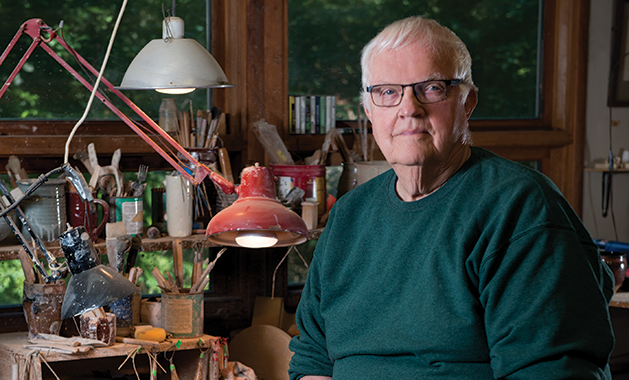
World traveler, solver of a 2000-year-old problem, teacher, and potter: these are just some of Mel Jacobson’s identities. The Minnetonka resident’s lifelong pottery adventure began when he saw renowned potter Warren MacKenzie give a demonstration at the Minnesota State Fair when Jacobson was a senior in high school. “I was absolutely enthralled,” he says. He became more involved in the arts in college when he took a painting class (initially, because he thought it would be an easy A, which ended up being false). He received high praise from his professor and a hard-to-get A-plus.
This led Jacobson to take a ceramics class given by MacKenzie years after he saw him at the fair. Jacobson began his art career painting and creating pottery, while also teaching ceramics at Hopkins High School. But he was always craving new knowledge. He wanted to study under a master potter, and eventually began an apprenticeship in Kyoto, Japan. “I took my wife and two kids, and I went to work every single day for a year and a half and made over 10,000 pieces,” he says.
His master, Kunio Uchida, was tough; Jacobson describes his first months in the studio as “hell.” But he persisted with Uchida. “If you want to be good at something, if you want to master anything, you have to be willing,” Jacobson says. After six months, Uchida said that Jacobson would be having a solo exhibition at the Matsuya gallery, which is one of the top art galleries in the world.
On Jacobson’s last day in the studio, he saw something on his potter’s wheel. It was a little stamp, inscribed with a Japanese character, which Jacobson couldn’t read. “One of the boys came up to me. It said ‘sama,’ which means 'person of importance,'” Jacobson remembers with a smile. Uchida never said a word—just quietly gave Jacobson his master certification. “Everything was worth it,” Jacobson says.
Many years after Jacobson’s trip to Japan, he was contacted by his friend Joe Koons with a 2000-year-old Chinese problem. Koons had been working for 50 years on a recipe to replicate the classic Chinese “hare’s fur” patterned glaze. Koons had worked with ceramics professors all over the world to test his formula, but no one could create the distinctive pattern. Jacobson describes hare’s fur as one of the most beautiful glazes in the history of China. But the art of making it had been lost for centuries. When Koons contacted Jacobson, he was more than ready to take on the challenge. He told Koons, “I will give you one entire summer, and I won’t do any of my own pots.” He devoted the time to the hare’s fur work.
Jacobson set to work building a special kiln and boxes used to house the pots. “I made about 100 pots and put them in the kiln, and I had hare’s fur the first time,” he says. Koons was ecstatic. The duo had multiple exhibitions, but the one Jacobson recalls best was at a gallery in Shanghai, where the director of the National Museum of China was in awe of his work. “That’s like going to the Louvre and the director of the Louvre likes your painting,” he says.
Even now, at age 82, Jacobson creates about 1,000 works each year. He’s also published two books. Pottery: A Life, a Lifetime is a reflection on his stay in Japan. 21st-Century Kilns is a how-to guide for building kilns from scratch. Jacobson continues to sell his pots at summer and winter sales every year; he also takes special order requests via email and Facebook.









